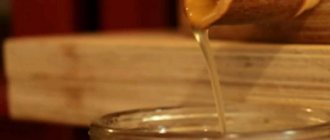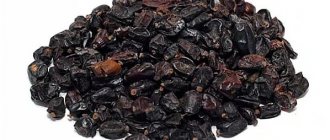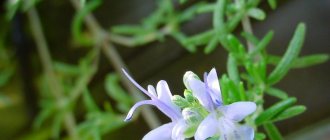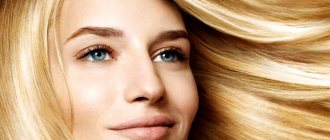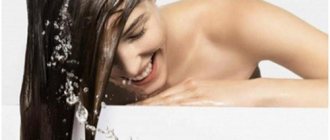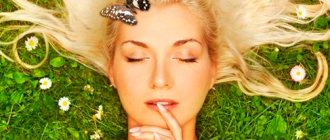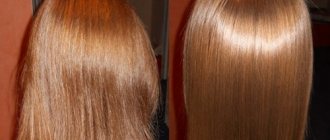What is Basma?
Basma is a powder of indigofera (a tropical shrub), which is obtained from its leaves, and has a greyish-marsh color. The dye is used to produce blue and black colors, but along with the coloring properties, this product has a healing effect. This method of dyeing was first carried out in the East.
Advantages and disadvantages
This natural dye has positive properties, due to which it is preferred to other chemical elements. The first thing that can be noted is the presence of vitamin C in the dye. This brings undoubted benefits to the hair, nourishing it, moisturizing and strengthening it. This vitamin is beneficial even for gray hair. Basma also nourishes the scalp, thereby stimulating the growth of new curls and making them healthier.
In ancient times, this natural component was used as a beneficial substance for the liver by ingesting it. Thus, the condition of the hair improves from the inside: dandruff, excessive oiliness of the hair and other problems are subsequently eliminated. Reviews from many women indicate that after using this dye, the strands stopped falling out and the hair became thicker. This product can also be used even if you are allergic to chemical dyes, without fear for your scalp.
It is fair to note that the dye also has disadvantages. Firstly, hair dyeing with basma should be done with caution and strictly following the instructions. It can give your hair an unwanted greenish or bluish tint. Secondly, if you overdo it with the composition or frequency of dyeing, you may dry out the strands.
It is not recommended to use basma in its pure form!
In what form is it produced?
On store shelves, Basma can be found in cardboard boxes with a clear print indicating the variety and basic characteristics of the product. Inside the package there is a hermetically sealed polymer bag with a powdery coloring composition.
The delivery set includes disposable cosmetic gloves. Basma is produced in packs weighing 25, 50, 100 and 125 g. Depending on the volume of packaging, the price of the product varies from 140 to 490 rubles.
The varieties of the product are named after the place where indigofera grows, from which the hair coloring composition is made. All varieties of the product have the same price.
Indian Basma
This is the most sought after and frequently used variety, which is called black henna. In different proportions, Indian basma provides a variety of shades and allows you to choose the color of curls that is as close as possible to natural.
Thanks to the fine grinding, the powder dissolves well in water, lays in an even layer on the curls, but is difficult to wash off. The Indian variety has a quick effect, has a pleasant aroma and gives a lasting coloring effect.
Turkish
Powder from the leaves of indigofera, which grows in Asia Minor, allows you to give your curls a wide range of restrained, noble and elegant shades. Turkish basma is preferred mainly by middle-aged women.
This product requires a little longer exposure to the hair than its Indian counterpart. Natural dye of Turkish origin, like all other varieties, is used only in combination with henna. Otherwise, the hair will acquire a greenish-blue tint.
Yemeni
The product gives a deep and rich color, reminiscent of the night sky of Arabia. The Yemeni variety, in addition to its expressive aesthetic effect, has many beneficial properties and medicinal effects.
With its help, you can strengthen the follicles and make the rods elastic.
To enhance the therapeutic effect, eliminate diffuse alopecia, and get rid of dandruff, the composition is mixed with:
- essential oils;
- hydrolates;
- herbal powders;
- conditioning components;
- vitamin compounds.
Hair basma (reviews confirm this) of Yemeni origin in different proportions with henna dyes curls in elegant dark chestnut shades or in the expressive and mysterious color of a raven's wing.
Iranian
The product is ideal for quickly changing the appearance and aesthetic image. Iranian basma refreshes the look. It provides a wide range of shades of curls - from copper-red to anthracite.
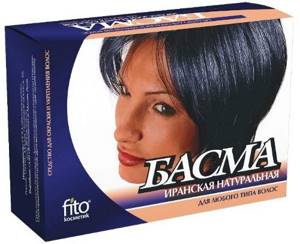
Cosmetics:
- has a general strengthening effect on the skin;
- improves the functional condition of the scalp,
- stimulates the growth of rods;
- prevents strands from breaking.
The Iranian variety creates an attractive shine to curls and maintains normal acid balance in the layers of the epidermis. The moisturizing effect is especially noticeable when combining the coloring composition with medicated shampoo or conditioner. The product smoothes out scales, making hair soft and pliable for styling.
How to paint?
Many people are interested in the question of how to dye their hair with basma. This dye in its pure form will give a green or blue tint to the strands, this will be especially noticeable if you have light hair. Weakened and damaged curls are intensively dyed, and the result may not please you.
Henna and basma do not interact with chemical elements, so dyeing should be done on undyed hair that has not previously been subject to other chemical treatment.
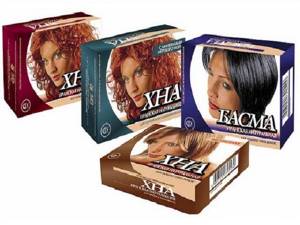
Basma on curls lasts for more than six months, but by the end of the period a reddish or purple tint may appear, so the color needs to be refreshed periodically, but this should not be done more than once a month - such a dye dries out the hair and scalp, and frequent dyeing can lead to negative consequences. consequences.
If you decide to give up painting with basma and switch to synthetic coloring, then the vegetable dye must be completely washed off, otherwise an unpredictable coloring result is possible due to the plant component reacting with the chemical one.
Having naturally dry and thin hair, it is advisable to add olive, castor or almond oil to the dye. Don't overdo it - the paint may not adhere well. This coloring mixture will add shine and additional moisture to dry curls.
Action
The balanced composition of natural phytodye, rich in useful substances, allows you to radically solve many dermatological and aesthetic problems, as well as achieve a radical change in your own appearance.
The high content of mineral elements in basma, with regular use of the product, helps strengthen the rods and prevents their spontaneous loss. Hair loss, called diffuse alopecia, is often caused by vitamin deficiency.
This leads to weakening of the follicles and the development of their dystrophic state. The process of hair loss is especially activated in early spring and in the autumn-winter period, when there is an acute shortage of nutrients necessary for the normal functioning of cells.
In addition to a variety of tint solutions, basma eliminates dandruff that occurs due to excessive dryness of the skin. Such a negative manifestation does not add attractiveness to the curls and is often accompanied by irritating itching.
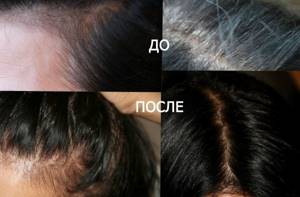
The photo shows the result of using basma for hair coloring.
Basma will not help solve this problem with a single use. Regular use of hair coloring product is required. The vitamin C contained in the herbal medicine has a moderate anti-inflammatory and antibacterial effect.
Minerals and tannins nourish hair columns, stimulate subcutaneous blood microcirculation, and activate regenerative processes in the cells of the surface layer of the epidermis. Basma normalizes the functioning of the sebaceous glands. It is effective for normal and oily hair, but is not suitable for pathologically dry hair.
Regular use of a natural herbal product gives your curls:
- elasticity;
- elasticity;
- attractive shine, comparable to the use of cosmetic compositions that contain silicone;
- smooth texture.
Hair dyed with basma is easy to comb, style well and straighten. A pleasant bonus is the activation of curl growth. The product will especially appeal to girls who want to quickly achieve long and even curls.
Basma for hair is an effective growth activator. This fact is especially noted in reviews by those who regularly use the product. The product protects the rods from the destructive effects of solar ultraviolet radiation and aggressive external chemical influences.
The vitamins contained in the natural phytodye are capable of binding heavy metal salts and toxic compounds, facilitating their evacuation when washed off. This product will be useful for girls who live in environmentally disadvantaged regions.
How to dye your hair with henna and basma?
The proportions of these components for various shades:
- to get a chestnut or chocolate color, use one to one proportions (equal proportions of powders of the two components);
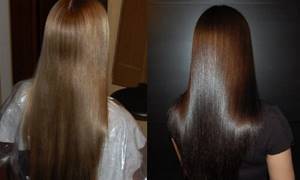
- the desired black color can be obtained by taking elements at the rate of 1 part of henna to two parts of basma;
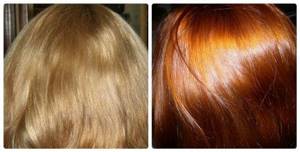
- to get a bronze shade, take two parts of henna and one part of basma.
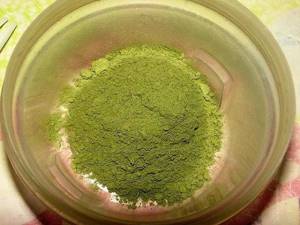
To protect yourself from unpredictable coloring results, try applying the color mixture to a separate strand of hair. If you are satisfied with the result, then feel free to apply it to the entire length. This combined dyeing takes place in two stages - first henna is applied, then basma, so dyeing at home will be more durable and the colors will be richer.
How to dilute the dye?
When preparing the coloring mixture, several rules should be followed. The dye powder is poured with hot water at a temperature of at least 90 degrees. The quantity is calculated depending on the length of the hair. Thus, for short curls you will need about 100 grams of powder, for medium length (from ten cm) - 200 grams, for long curls (below the shoulder blades) - 300 grams, and if the strands are waist-length, you will need 500 grams.
The mixture should be applied to the strands while it is still hot.
When mixing the dye with henna or other components, the technology for preparing the mixture is no different; you just need to add the required amount to the powder. It is also worth noting that at too high temperatures, henna is baked, for this reason the water needs to be cooled a little (70-80 degrees).
Advantages and disadvantages
Vegetable dye has many benefits.
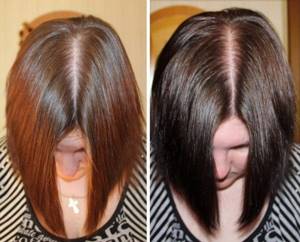
The most significant of them include:
- environmental friendliness of the product;
- no harm to hair, unlike chemical dyes;
- healing of wounds and microcracks of the scalp;
- pronounced anti-inflammatory, fungicidal and antibacterial effects;
- protection of the scalp and epidermis from the negative influence of external factors;
- variety of color solutions;
- affordable price;
- strengthening follicles;
- eliminating dandruff;
- intensification of curl growth;
- increasing the thickness, elasticity, strength and resilience of curls with regular use.
Basma is a universal coloring agent that is compatible with different skin and hair types. Among the disadvantages, one can highlight the difficulty of washing off the epidermal tissues surrounding the curls. To facilitate this procedure, you have to use a rich cream.
A significant disadvantage is that when basma is used for the first time, the result is unpredictable and far from desired. If you curl your hair after dyeing, it will turn green due to high temperature exposure, which is noted by many reviews. The product is not suitable for pathologically dry curls, which should be considered one of the obvious disadvantages of the product.
Basma for gray hair
To dye your hair at home and get rid of gray hair, you need to stretch out the process over several days. You won’t be able to get a beautiful shade right away if you have a large number of gray strands - perhaps not all your hair will be dyed. For dry and damaged curls, add oil to the dye mixture at each stage so as not to dry out your hair.
Adding natural ingredients such as tea, Cahors and coffee allows you to get more noble colors and cover gray hair more thoroughly. For women whose hair color is ashy or blonde, these hair dyes are not suitable. The color will turn out tangerine, and washing it off will be problematic.
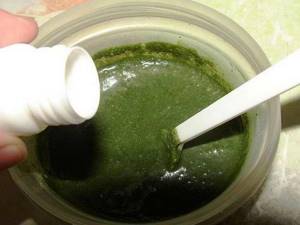
To get a black color, you need to take equal proportions of the components; this recipe is especially suitable for painting gray hair on brunettes. If you did not get the desired black color and did not remove the gray hair, then the next day you need to carefully paint the problem areas again, it is better that the components are in the same proportions.
Other shades
If you want to get an unusual color, use the following recipes when painting:
- For a light chocolate color, add weak tea leaves or coffee to the paint mixture.
- To cover gray hair and get beautiful ruby shades, henna is used along with basma and heated Cahors.
- Adding chamomile infusion gives rich golden colors.

Henna, when mixed with basma, does not give black color to light hair; for these purposes it is better to use synthetic dyes.
Coloring with these components will not necessarily give only a black tint; by adding various components, you can get interesting colors and perfectly cover gray hair.
Dyeing process
Dyeing strands with natural dyes should only be done with a freshly prepared mixture; during long-term storage, the components will oxidize, and the result will not be what you planned. To protect your neck from staining, wear a bandage or wrap it in cellophane. Apply a rich cream along the hair growth - this will help you easily wash off the dye in case of accidental contact.
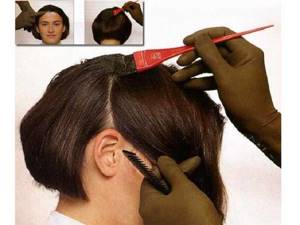
The composition is applied according to the same rules as synthetic dye - careful dyeing strand by strand. The coloring components have a fluid composition and can easily drain from the hair, so you can add oil or glycerin to the mixture for better retention.
The lighter the shade you want, the less time you will need to dye. This usually takes from 1.5 to 6 hours. It all depends on the structure and susceptibility of the curls to dyeing, so it’s better to try on one strand to calculate the exposure time.
How to wash off the paint after the procedure?
This mixture is quite problematic to wash off, this is worth taking into account. You need to rinse your hair extremely thoroughly, otherwise, after drying, powder will remain throughout all the curls.
The mixture is washed off with running water without using shampoo. If the basma is stale, then a few drops of ammonia will help revive it.
At the end of the wash, you can use conditioner. It is recommended to use regular shampoo only after a few days.
What does the coloring result depend on?
Hair color after the procedure depends on many factors. Even when using the same recipe, according to reviews, two people's curls can have completely different shades.
What does the final result of the procedure depend on:
- Natural hair color that will be dyed;
- The structure of the hair - its thickness, degree of dryness, softness. Damaged curls, as well as dry and soft hair, are colored noticeably faster;
- The hotter the water with which the mixture is diluted, and the higher the temperature of the mixture itself when applied, the faster your hair will color;
- The longer you keep the basma on your head, the better it will color.
Important read: Ombre dyeing for short hair
If after the procedure you get a too rich shade, you can reduce its intensity with vegetable oil.
To do this, the oil is slightly heated and applied to the curls for about half an hour, after which it is washed off with detergent.
If after the first such procedure the color is still bright, then it is repeated the required number of times. You can also use lemon juice for the same purposes.
Squeeze the juice of one lemon onto your hair for about 5-10 minutes, after which you need to rinse your hair with water.
Coloring results in the photo.
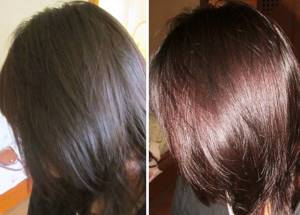
Dyeing with basma black
To dye your basma curls black you will need:
First, apply henna staining. Holding time 60 minutes; remove the paint and dry the curls; Now basma is applied, it needs to act for half an hour on light brown curls, 1.5 hours on chestnut ones, 3 hours on dark ones.
To enhance the work of basma, a little ammonia is dripped into it, but then shorten the exposure time. The dye should be washed off without using detergent until clear water begins to flow from the hair.
During the first 6 hours the shade will still darken. At first, a greenish tone may appear, but it will go away after a couple of days after the basma has oxidized. After two days, the curls will turn black. Dyeing inside the hair under the influence of oxygen lasts another day.
But if waiting a long time does not suit you, then wash off the dye with shampoo. And if the outcome is undesirable, moisten your curls with lemon juice and rinse them after 10 minutes.
If the result is undesirable, you can change the shade. But with prolonged action of basma, it is almost impossible to wash off the color. Therefore, do not keep the paint on for too long.
The shade can be changed, it depends on what pigment the basma is mixed with: tea, cocoa, beet juice, coffee, etc. For example, a rich shade of chocolate is achieved by using a composition that includes basma, henna and tinting agent.

